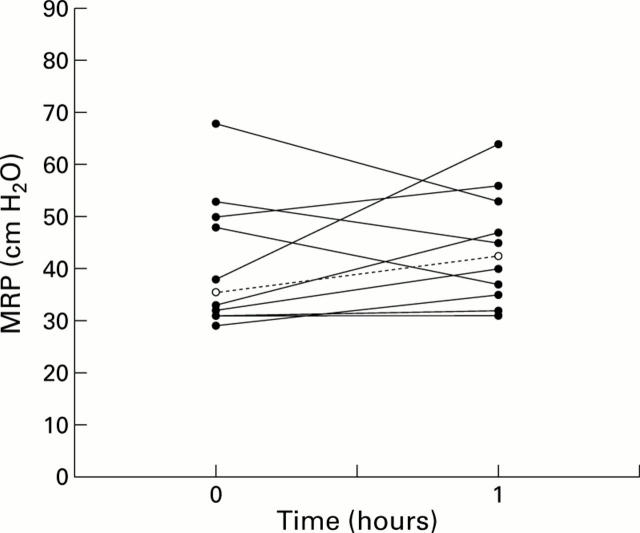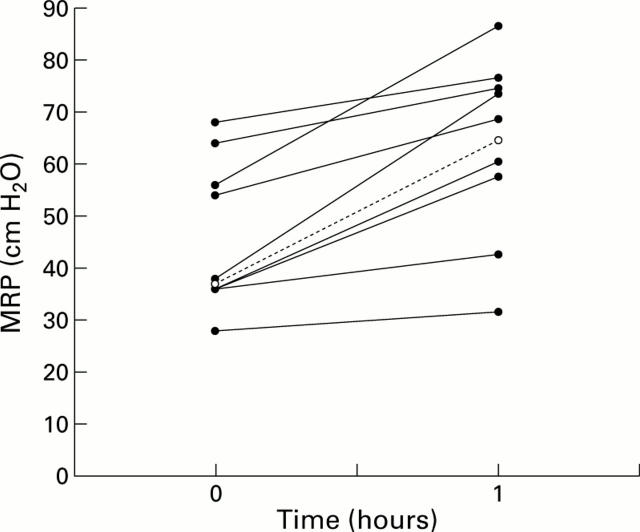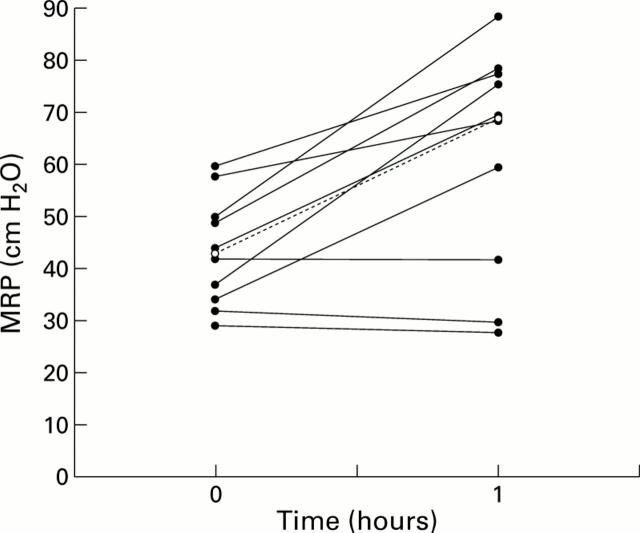Abstract
INTRODUCTION—The internal anal sphincter receives a stimulatory alpha1 adrenergic innervation. Use of an adrenergic agonist may therefore have a role in treating patients with faecal incontinence. METHODS—Ten patients (seven females, median age 66 years) with passive faecal incontinence related to weak internal anal sphincter were studied. All patients had intact anal sphincters as assessed by endoanal ultrasound. Phenylephrine gel was applied in a double blind manner in concentrations of 0%, 10%, 20%, 30%, and 40% (Slaco Pharma (UK) Ltd, Watford, UK) on separate days. Maximum resting anal pressure (MRP), anodermal blood flow, blood pressure, and pulse rate were measured before, and one and two hours after application. RESULTS—All concentrations of phenylephrine gel increased median MRP (43, 48, 54, 65, and 70 cm H2O, for placebo, 10% (p=0.122), 20% (p=0.170), 30% (p=0.002), and 40% (p=0.004), respectively at one hour; comparisons with placebo). This was sustained at two hours. There was a clear dose-response relationship at one hour. Higher concentrations raised median MRP to within the normal range (> 60 cm H2O). At two hours, all concentrations greater than 20% increased the pressure to a similar degree, suggesting that the exact concentration may be important for the initial effect but given a certain threshold is less important after a period of time. Toxicity was rare. Two patients experienced transient perianal burning which settled within a few minutes. There was no significant effect on anodermal blood flow, blood pressure, or pulse rate. CONCLUSION—This study has demonstrated the feasibility of using topical phenylephrine to raise resting anal tone in patients with faecal incontinence. Randomised controlled trials are required to assess the efficacy of this agent. Keywords: phenylephrine; faecal incontinence; anal tone
Full Text
The Full Text of this article is available as a PDF (106.1 KB).
Figure 1 .
Effect of a single application of placebo gel on maximum anal resting pressure (MRP) in 10 patients with faecal incontinence, measured prior to application and one hour after application (broken line indicates median values)
Figure 2 .
Effect of a single application of 30% phenylephrine gel on maximum anal resting pressure (MRP) in 10 patients with faecal incontinence, measured prior to application and one hour after application (broken line indicates median values)
Figure 3 .
Effect of a single application of 40% phenylephrine gel on maximum anal resting pressure (MRP) in 10 patients with faecal incontinence, measured prior to application and one hour after application (broken line indicates median values)
Selected References
These references are in PubMed. This may not be the complete list of references from this article.
- Añbarro B., Barranco P., Ojeda J. A. Allergic contact blepharoconjunctivitis caused by phenylephrine eyedrops. Contact Dermatitis. 1991 Nov;25(5):323–324. doi: 10.1111/j.1600-0536.1991.tb01882.x. [DOI] [PubMed] [Google Scholar]
- Baeten C. G., Konsten J., Spaans F., Visser R., Habets A. M., Bourgeois I. M., Wagenmakers A. J., Soeters P. B. Dynamic graciloplasty for treatment of faecal incontinence. Lancet. 1991 Nov 9;338(8776):1163–1165. doi: 10.1016/0140-6736(91)92030-6. [DOI] [PubMed] [Google Scholar]
- Bharucha A. E., Camilleri M., Zinsmeister A. R., Hanson R. B. Adrenergic modulation of human colonic motor and sensory function. Am J Physiol. 1997 Nov;273(5 Pt 1):G997–1006. doi: 10.1152/ajpgi.1997.273.5.G997. [DOI] [PubMed] [Google Scholar]
- Carapeti E. A., Kamm M. A., Evans B. K., Phillips R. K. Topical phenylephrine increases anal sphincter resting pressure. Br J Surg. 1999 Feb;86(2):267–270. doi: 10.1046/j.1365-2168.1999.01021.x. [DOI] [PubMed] [Google Scholar]
- Carapeti E. A., Kamm M. A., Phillips R. K. Randomized controlled trial of topical phenylephrine in the treatment of faecal incontinence. Br J Surg. 2000 Jan;87(1):38–42. doi: 10.1046/j.1365-2168.2000.01306.x. [DOI] [PubMed] [Google Scholar]
- Engel A. F., Kamm M. A., Bartram C. I., Nicholls R. J. Relationship of symptoms in faecal incontinence to specific sphincter abnormalities. Int J Colorectal Dis. 1995;10(3):152–155. doi: 10.1007/BF00298538. [DOI] [PubMed] [Google Scholar]
- Engel A. F., Kamm M. A., Sultan A. H., Bartram C. I., Nicholls R. J. Anterior anal sphincter repair in patients with obstetric trauma. Br J Surg. 1994 Aug;81(8):1231–1234. doi: 10.1002/bjs.1800810853. [DOI] [PubMed] [Google Scholar]
- Fraunfelder F. T., Scafidi A. F. Possible adverse effects from topical ocular 10% phenylephrine. Am J Ophthalmol. 1978 Apr;85(4):447–453. doi: 10.1016/s0002-9394(14)75239-0. [DOI] [PubMed] [Google Scholar]
- Law P. J., Bartram C. I. Anal endosonography: technique and normal anatomy. Gastrointest Radiol. 1989 Fall;14(4):349–353. doi: 10.1007/BF01889235. [DOI] [PubMed] [Google Scholar]
- Mortensen N., Humphreys M. S. The anal continence plug: a disposable device for patients with anorectal incontinence. Lancet. 1991 Aug 3;338(8762):295–297. doi: 10.1016/0140-6736(91)90428-r. [DOI] [PubMed] [Google Scholar]
- O'Kelly T. J., Brading A., Mortensen N. J. In vitro response of the human anal canal longitudinal muscle layer to cholinergic and adrenergic stimulation: evidence of sphincter specialization. Br J Surg. 1993 Oct;80(10):1337–1341. doi: 10.1002/bjs.1800801041. [DOI] [PMC free article] [PubMed] [Google Scholar]
- Penninckx F., Lestar B., Kerremans R. The internal anal sphincter: mechanisms of control and its role in maintaining anal continence. Baillieres Clin Gastroenterol. 1992 Mar;6(1):193–214. doi: 10.1016/0950-3528(92)90027-c. [DOI] [PubMed] [Google Scholar]
- Regadas F. S., Batista L. K., Albuquerque J. L., Capaz F. R. Pharmacological study of the internal and sphincter in patients with chronic anal fissure. Br J Surg. 1993 Jun;80(6):799–801. doi: 10.1002/bjs.1800800650. [DOI] [PubMed] [Google Scholar]
- Speakman C. T., Hoyle C. H., Kamm M. A., Henry M. M., Nicholls R. J., Burnstock G. Adrenergic control of the internal anal sphincter is abnormal in patients with idiopathic faecal incontinence. Br J Surg. 1990 Dec;77(12):1342–1344. doi: 10.1002/bjs.1800771208. [DOI] [PubMed] [Google Scholar]
- Speakman C. T., Hoyle C. H., Kamm M. A., Swash M., Henry M. M., Nicholls R. J., Burnstock G. Abnormal internal anal sphincter fibrosis and elasticity in fecal incontinence. Dis Colon Rectum. 1995 Apr;38(4):407–410. doi: 10.1007/BF02054231. [DOI] [PubMed] [Google Scholar]
- Sultan A. H., Kamm M. A., Hudson C. N., Thomas J. M., Bartram C. I. Anal-sphincter disruption during vaginal delivery. N Engl J Med. 1993 Dec 23;329(26):1905–1911. doi: 10.1056/NEJM199312233292601. [DOI] [PubMed] [Google Scholar]
- Vaizey C. J., Carapeti E., Cahill J. A., Kamm M. A. Prospective comparison of faecal incontinence grading systems. Gut. 1999 Jan;44(1):77–80. doi: 10.1136/gut.44.1.77. [DOI] [PMC free article] [PubMed] [Google Scholar]
- Vaizey C. J., Kamm M. A., Bartram C. I. Primary degeneration of the internal anal sphincter as a cause of passive faecal incontinence. Lancet. 1997 Mar 1;349(9052):612–615. doi: 10.1016/S0140-6736(96)09188-X. [DOI] [PubMed] [Google Scholar]
- Vaizey C. J., Kamm M. A., Gold D. M., Bartram C. I., Halligan S., Nicholls R. J. Clinical, physiological, and radiological study of a new purpose-designed artificial bowel sphincter. Lancet. 1998 Jul 11;352(9122):105–109. doi: 10.1016/s0140-6736(98)85014-9. [DOI] [PubMed] [Google Scholar]
- Yamato S., Rattan S. Role of alpha adrenoceptors in opossum internal anal sphincter. J Clin Invest. 1990 Aug;86(2):424–429. doi: 10.1172/JCI114728. [DOI] [PMC free article] [PubMed] [Google Scholar]





